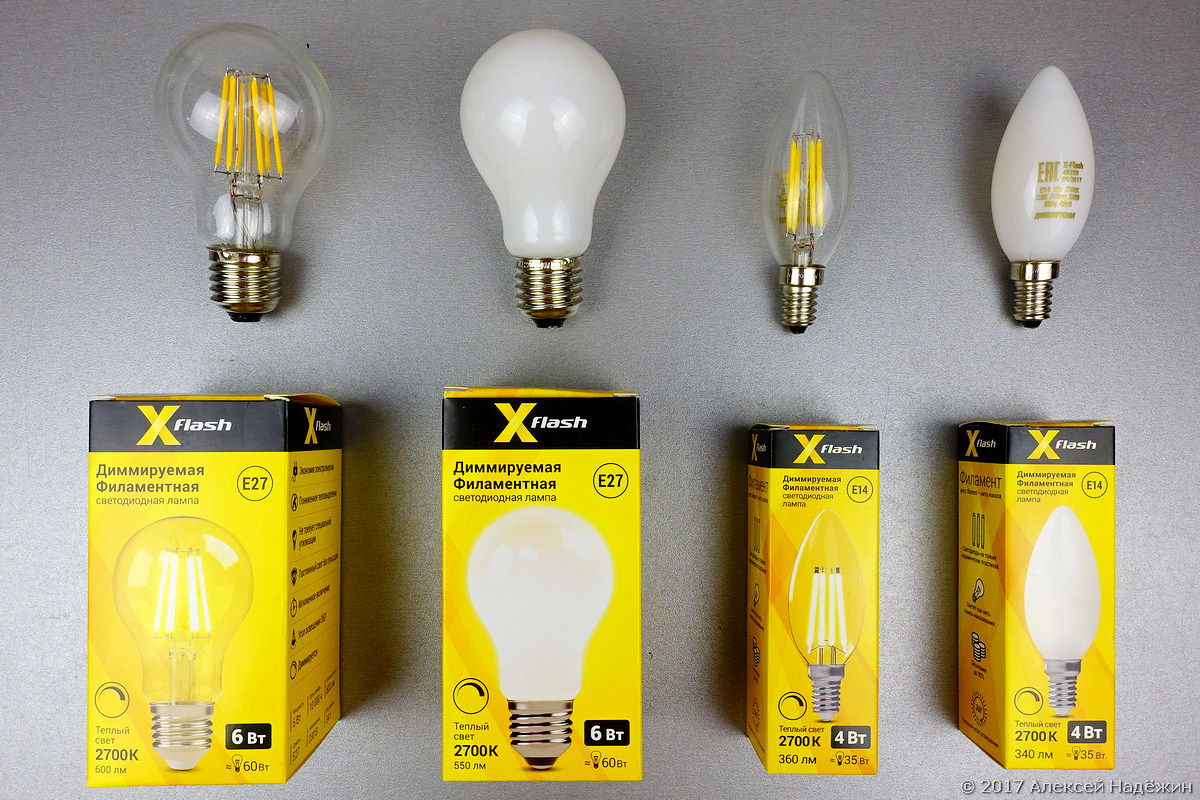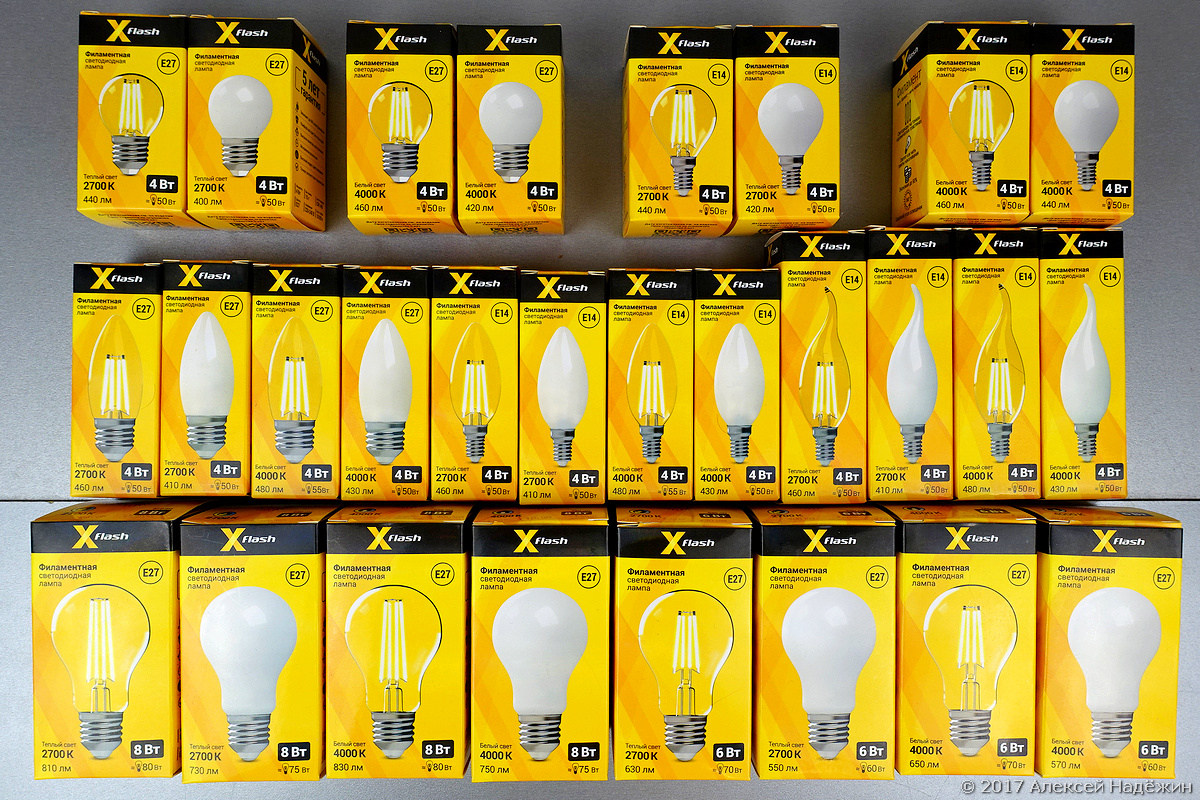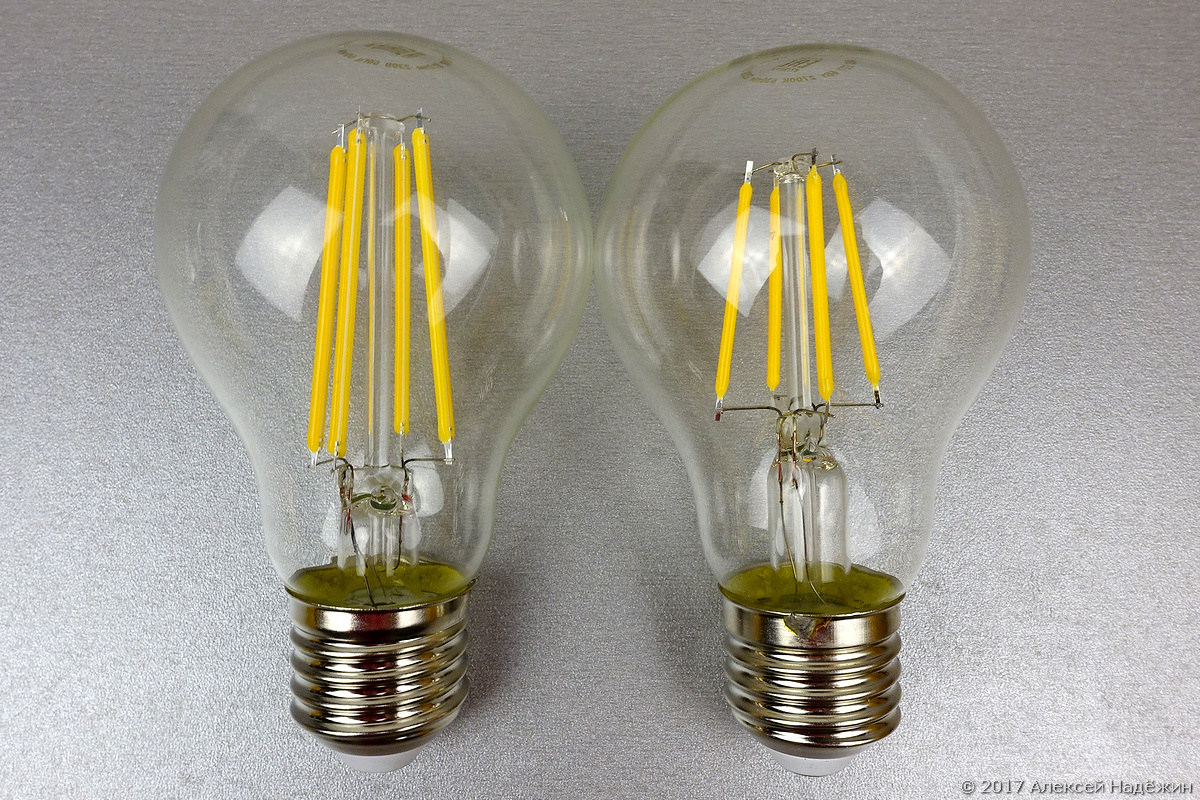New X-Flash Filament LED Bulbs
Until recently, most of the filament lamps were transparent and did not support brightness control. Now matte and dimmable filament lamps have appeared in the assortment of several leading brands, including X-Flash - the only manufacturer that gives a 5-year warranty on filament lamps and is known for always showing honest characteristics on the packaging of lamps.
I tested these lamps, and at the same time all X-Flash filament lamps from the new range.

At the beginning of 2015, the first new type of LED lamps appeared on the market - on LED filaments (filaments). The light of such lamps is very similar to the light of ordinary incandescent bulbs, and they look almost the same - a glass bulb in which, instead of a filament, there are 4-8 glowing LED threads (each thread is a metal, glass or sapphire plate with a lot of small LEDs covered common phosphor).
')
The filament lamps differ from ordinary LED lamps not only externally, but also in light parameters: they have higher efficiency (up to 120 lm / W), a wider angle of illumination, and the light is directed more to the sides than forward. In addition, in the production of filaments, high-quality phosphor is always used, and all filament llamas have a color rendition index (CRI, Ra) above 80.
Unlike conventional lamps, filament lamps do not have radiators that cool the LEDs; therefore, the service life of such lamps is generally shorter and depends very much on how full the lamp bulb is. Cheap cheap filament lamps can have air inside and such lamps burn out after a couple of months. Bulb quality lamps filled with helium, able to remove heat from the filaments.
The electronic board (driver) in a conventional LED lamp is located in the opaque part of the lamp at the base and can be quite large. The only place where the driver can be positioned at the filament lamp is the base itself, so the driver board is very small, especially for lamps with an E14 base (minion). It is difficult to make a good driver of such a small size, so you can often find cheap filament lamps with unacceptably high light pulsation (up to 100%). For the same reason, filament lamps with the support of brightness control (dimming) did not appear for a long time.
At first, the filament lamps were perceived by manufacturers as decorative, therefore at the beginning they were produced only transparent. Now, many manufacturers are confident that the future is precisely because of the filament LED lamps, which is why matte and dimmable lamps of this type have finally appeared.
Now there are four dimmable filament lamps in the X-Flash assortment - 6 W “pear” E27 transparent and frosted for 399 rubles and 4 W “candle” E14 transparent and frosted for 299 rubles. All with a color temperature of 2700 K.

The lamps used an unusual dimming scheme - usually LED lamps require a more "deep" dimming than incandescent lamps - when a regular and dimmable LED lamp is connected in parallel to the dimmer when the brightness decreases, the incandescent lamp goes out much longer, and the LED lamp still pretty bright lit. Because of this, with many dimmers it is not possible to achieve low brightness values of LED lamps at the minimum level of dimming. X-Flash has a scheme that adjusts the brightness in almost the same way as incandescent bulbs. A significant advantage of this scheme is that most conventional dimmers are able to lower the brightness of the lamps to almost zero, but there is also a minus - with some dimmers the lamps never burn at full brightness at the maximum adjustment value.
I checked the operation of the lamps with dimmers Lezard 800W, Legrand 7702 61 40-400W, Ying Hua 15-200W (most common on Aliexpress), Simon 1591796-030 5-215W LED, X-Flash 47475 XF-DIM-300W-220V, Noolite SU111-300, EasyDim RX-AC-DIM 100W. The dimming of two lamps connected in parallel was checked. Four-wire dimmers X-Flash and EasyDim adjust the brightness from 0 to 100%. Lezard and Simon dimmers adjust the brightness from 0 to 99%, Legrand from 1 to 100%, at luminances less than 1% flicker starts, Noolite does not allow to “catch” brightness less than 7%, Ying Hua adjusts the brightness only from 18 to 100%.
The luminous flux of the lamps was measured using a two-meter integrating sphere and a Instrument Systems spectrometer , the lighting angle and consumption characteristics of the Viso Light Spion instrument, the power consumption of the Robiton PM-2 instrument, the color rendering index, color temperature and pulsation with the Uprtek MK350D instrument . The minimum operating voltage, at which the luminous flux decreased by no more than 10% of the nominal, was measured using a Lamptest-1 device, Stable Stab Instab 500 , LATP Suntek TDGC2-0.5 and an Aneng AN8001 multimeter .

The luminous flux of the lamps is slightly less than stated, but not more than 10%, which is permissible according to GOST R 54815-2011 .
The matte coating of the flask adds yellowness to the light, and the color temperature of the matte lamps is approximately 100K lower than that of the transparent ones.
The color rendering index of the lamps is 82-83, so they can be recommended for use in residential areas.
The level of light pulsation does not exceed 1.5%.
Lamps work correctly with switches that have an indicator.
The lamps use linear drivers, so when the supply voltage decreases, their brightness decreases linearly. The voltage at which the lamps give 90% of the brightness of the nominal, is 219-222 V, so these lamps should not be used where there is a low or high voltage in the network.
The brightness of frosted dimmable lamps may be insufficient, because a pear lamp giving 532 lm can replace only an incandescent lamp of 50-55 W, and a candle lamp with a luminous flux of 305 lm will replace an incandescent lamp of 30-35 W, but 40 W .
All non-dimmable X-Flash filament lamps are now available with clear and frosted glass.

Transparent lamps have the same items and barcodes as the lamps of 2015 and 2016, but differ in design - earlier there were eight threads in an 8-watt lamp, and six in a 6-watt lamp, now all four lamps of four high power are used in all the lamps.

Lamps of 2017: on the left - 8 W, on the right - 6 W.
Measurement results:

The luminous flux of the lamps is quite a bit different from the stated. In some lamps it is 2-6% less than stated, in some it is 1-12% more than declared.
The measured color rendition index (CRI, Ra) of all lamps is 80-85 and only one lamp has 79. Most likely, it is exactly 80 and this is just a measurement error. Lamps can be recommended for residential use.
The level of light pulsation of all lamps does not exceed 0.3%.
As with dimmable lamps, the matte coating of the flask adds yellowness to light, and the color temperature of matte lamps with warm light is about 100K less than that of transparent ones, and that of matte lamps with cold light has an average temperature of 250K.
All lamps work correctly with switches that have an indicator.
The lamps use linear drivers, so when the supply voltage decreases, their brightness decreases linearly. The voltage at which the lamps give 90% of the brightness of the nominal, is 208-214 V, so these lamps should not be used where there is a low or high voltage in the network.
For all filament lamps, the manufacturer claims a service life of 10,000 hours and at the same time gives a warranty of 5 years.
All the parameters of the tested lamps, as well as all the other results of my tests of LED lamps, look at lamptest.ru .
© 2017, Alexey Nadyozhin
I tested these lamps, and at the same time all X-Flash filament lamps from the new range.

At the beginning of 2015, the first new type of LED lamps appeared on the market - on LED filaments (filaments). The light of such lamps is very similar to the light of ordinary incandescent bulbs, and they look almost the same - a glass bulb in which, instead of a filament, there are 4-8 glowing LED threads (each thread is a metal, glass or sapphire plate with a lot of small LEDs covered common phosphor).
')
The filament lamps differ from ordinary LED lamps not only externally, but also in light parameters: they have higher efficiency (up to 120 lm / W), a wider angle of illumination, and the light is directed more to the sides than forward. In addition, in the production of filaments, high-quality phosphor is always used, and all filament llamas have a color rendition index (CRI, Ra) above 80.
Unlike conventional lamps, filament lamps do not have radiators that cool the LEDs; therefore, the service life of such lamps is generally shorter and depends very much on how full the lamp bulb is. Cheap cheap filament lamps can have air inside and such lamps burn out after a couple of months. Bulb quality lamps filled with helium, able to remove heat from the filaments.
The electronic board (driver) in a conventional LED lamp is located in the opaque part of the lamp at the base and can be quite large. The only place where the driver can be positioned at the filament lamp is the base itself, so the driver board is very small, especially for lamps with an E14 base (minion). It is difficult to make a good driver of such a small size, so you can often find cheap filament lamps with unacceptably high light pulsation (up to 100%). For the same reason, filament lamps with the support of brightness control (dimming) did not appear for a long time.
At first, the filament lamps were perceived by manufacturers as decorative, therefore at the beginning they were produced only transparent. Now, many manufacturers are confident that the future is precisely because of the filament LED lamps, which is why matte and dimmable lamps of this type have finally appeared.
Now there are four dimmable filament lamps in the X-Flash assortment - 6 W “pear” E27 transparent and frosted for 399 rubles and 4 W “candle” E14 transparent and frosted for 299 rubles. All with a color temperature of 2700 K.

The lamps used an unusual dimming scheme - usually LED lamps require a more "deep" dimming than incandescent lamps - when a regular and dimmable LED lamp is connected in parallel to the dimmer when the brightness decreases, the incandescent lamp goes out much longer, and the LED lamp still pretty bright lit. Because of this, with many dimmers it is not possible to achieve low brightness values of LED lamps at the minimum level of dimming. X-Flash has a scheme that adjusts the brightness in almost the same way as incandescent bulbs. A significant advantage of this scheme is that most conventional dimmers are able to lower the brightness of the lamps to almost zero, but there is also a minus - with some dimmers the lamps never burn at full brightness at the maximum adjustment value.
I checked the operation of the lamps with dimmers Lezard 800W, Legrand 7702 61 40-400W, Ying Hua 15-200W (most common on Aliexpress), Simon 1591796-030 5-215W LED, X-Flash 47475 XF-DIM-300W-220V, Noolite SU111-300, EasyDim RX-AC-DIM 100W. The dimming of two lamps connected in parallel was checked. Four-wire dimmers X-Flash and EasyDim adjust the brightness from 0 to 100%. Lezard and Simon dimmers adjust the brightness from 0 to 99%, Legrand from 1 to 100%, at luminances less than 1% flicker starts, Noolite does not allow to “catch” brightness less than 7%, Ying Hua adjusts the brightness only from 18 to 100%.
The luminous flux of the lamps was measured using a two-meter integrating sphere and a Instrument Systems spectrometer , the lighting angle and consumption characteristics of the Viso Light Spion instrument, the power consumption of the Robiton PM-2 instrument, the color rendering index, color temperature and pulsation with the Uprtek MK350D instrument . The minimum operating voltage, at which the luminous flux decreased by no more than 10% of the nominal, was measured using a Lamptest-1 device, Stable Stab Instab 500 , LATP Suntek TDGC2-0.5 and an Aneng AN8001 multimeter .

The luminous flux of the lamps is slightly less than stated, but not more than 10%, which is permissible according to GOST R 54815-2011 .
The matte coating of the flask adds yellowness to the light, and the color temperature of the matte lamps is approximately 100K lower than that of the transparent ones.
The color rendering index of the lamps is 82-83, so they can be recommended for use in residential areas.
The level of light pulsation does not exceed 1.5%.
Lamps work correctly with switches that have an indicator.
The lamps use linear drivers, so when the supply voltage decreases, their brightness decreases linearly. The voltage at which the lamps give 90% of the brightness of the nominal, is 219-222 V, so these lamps should not be used where there is a low or high voltage in the network.
The brightness of frosted dimmable lamps may be insufficient, because a pear lamp giving 532 lm can replace only an incandescent lamp of 50-55 W, and a candle lamp with a luminous flux of 305 lm will replace an incandescent lamp of 30-35 W, but 40 W .
All non-dimmable X-Flash filament lamps are now available with clear and frosted glass.

Transparent lamps have the same items and barcodes as the lamps of 2015 and 2016, but differ in design - earlier there were eight threads in an 8-watt lamp, and six in a 6-watt lamp, now all four lamps of four high power are used in all the lamps.

Lamps of 2017: on the left - 8 W, on the right - 6 W.
Measurement results:

The luminous flux of the lamps is quite a bit different from the stated. In some lamps it is 2-6% less than stated, in some it is 1-12% more than declared.
The measured color rendition index (CRI, Ra) of all lamps is 80-85 and only one lamp has 79. Most likely, it is exactly 80 and this is just a measurement error. Lamps can be recommended for residential use.
The level of light pulsation of all lamps does not exceed 0.3%.
As with dimmable lamps, the matte coating of the flask adds yellowness to light, and the color temperature of matte lamps with warm light is about 100K less than that of transparent ones, and that of matte lamps with cold light has an average temperature of 250K.
All lamps work correctly with switches that have an indicator.
The lamps use linear drivers, so when the supply voltage decreases, their brightness decreases linearly. The voltage at which the lamps give 90% of the brightness of the nominal, is 208-214 V, so these lamps should not be used where there is a low or high voltage in the network.
For all filament lamps, the manufacturer claims a service life of 10,000 hours and at the same time gives a warranty of 5 years.
All the parameters of the tested lamps, as well as all the other results of my tests of LED lamps, look at lamptest.ru .
© 2017, Alexey Nadyozhin
Source: https://habr.com/ru/post/374013/
All Articles